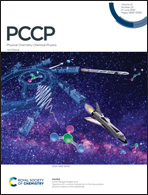Pressure-induced isostructural phase transition in Ti3AlC2: experimental and theoretical investigation
Abstract
The structural stability of Ti3AlC2 under high pressure is important for understanding its mechanical properties. Here, we conducted a high hydrostatic pressure synchrotron X-ray diffraction experiment and no structural phase transition was observed. Like most other MAX phases, Ti3AlC2 showed an anisotropic compression behavior. Most importantly, an anomaly in c/a ratio was observed at 20.3 GPa, indicating that a pressure-induced isostructural phase transition occurred here. Analysis of the electronic band structure and Fermi surface revealed that three bands crossed the Fermi surface under compression, which suggested that this isostructural phase transition can be considered to be motivated by an electronic topological transition. The subsequent Hall-effect measurements reconfirmed this variation of the electronic band at the Fermi surface, which can be regarded as the electronic origin for the observed isostructural phase transition. These results enrich the basic property data of Ti3AlC2 and would benefit the further understanding of this promising material.



 Please wait while we load your content...
Please wait while we load your content...